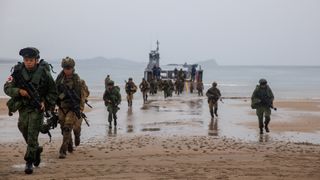A new report from the United States Studies Centre (USSC) outlines key initiatives that promote how Indonesia, the Philippines, Singapore and Vietnam can work more effectively with Australia and the United States on maritime security issues in the South China Sea.
In the report Many hands: Australia-US contributions to Southeast Asian maritime security resilience, USSC Research Fellow Dr Peter K. Lee worked with regional experts to identify the top maritime threats and opportunities in the region.
“Australia and the United States have each invested heavily in maritime security cooperation with key Southeast Asian partners over many decades. But China’s militarisation of features in the South China Sea and use of maritime coercion requires new ways of thinking about collective resilience. There is an opportunity for the Australia-US Alliance to play a more active, joint role in this effort,” Dr Lee noted.
The report includes chapters on Indonesia by Mr Ristian Atriandi Supriyanto from Universitas Indonesia and S. Rajaratnam School of International Studies, Philippines by Professor Renato Cruz De Castro from De La Salle University, Singapore by Dr Collin Koh from the S. Rajaratnam School of International Studies and Vietnam by Dr Lan-Anh Nguyen from the Diplomatic Academy of Vietnam.
“There is a growing constituency throughout Southeast Asia who recognise that existing responses have been insufficient and that new strategies are needed. Our report showcases some of the leading Southeast Asian voices in this debate. The four authors share their assessments about what the Australia-US Alliance could do to empower their countries to better defend their maritime interests against coercion,” Dr Lee explained.
Dr Lee notes that “The authors reflect the diversity of regional reviews about what Australia and the United States could be doing. I synthesised some of these into four pathways that Australian and US policymakers could jointly consider. The pathways are not mutually exclusive, but they do present trade-offs in how Australia and the United States allocate limited defence resources throughout the South China Sea.”
Key points
- While Australia and the United States already pursue a range of security cooperation activities in Southeast Asia, this report examines how they can work together to strengthen the maritime security resilience of key Southeast Asian partners.
- For Indonesia, Ristian Supriyanto looks at how exercises and patrols; defence capability transfers; industrial and technological collaboration; and education and training can be enhanced, with a focus on trilateral military exercises and coordinated patrols.
- For the Philippines, Renato De Cruz Castro discusses how Manila’s bilateral security relations with each partner have struggled to align trilaterally and why legal frameworks need to be updated to support Manila’s force modernisation efforts.
- For Singapore, Collin Koh examines how the robust access, training and logistics arrangements with both partners can also support more holistic cooperation to build regional security resilience such as infrastructure financing.
- For Vietnam, Lan-Anh Nguyen focuses on how Australia and the United States can play complementary roles in supporting capacity building and maritime domain awareness while also improving multi-domain resilience.
- Pathways by which Australia and the United States could support their Southeast Asian partners;
- Accelerate naval and coastal shipbuilding programs.
- Prioritise lethal high-end munitions and strike capabilities.
- Expand maritime surveillance data-sharing.
- Increase Australian and US access arrangements and expand presence operations.
Enquiries
USSC Media
T 0468 480 165
E ussc.media@sydney.edu.au





